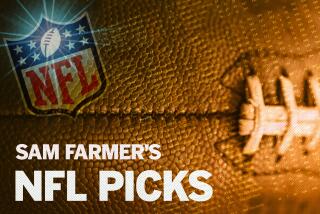Pro Football : Cowboys Could Help Themselves by Having Landry Call Plays
- Share via
The 2-12 Dallas Cowboys have never before lost a dozen games in a season. But they didn’t just suddenly fall apart. They finished 7-8 last season and 7-9 in 1986.
And Sid Gillman has come up with an explanation.
Gillman, one of several former National Football League coaches in the Hall of Fame, attributes the Cowboys’ decline to Coach Tom Landry’s decision to stop calling signals.
“They were a champion when Tom was sending in every play,” Gillman said this week. “He has a fertile mind, one of the best in football, and he has some talent there in Dallas.
“The Cowboys will be a contender again next year if Tom involves himself in the offense the way he used to and starts calling the plays again.”
Gillman said that it’s difficult for any football coach to win unless he personally takes charge of offense or defense.
“And defense is more of a guessing game,” he said. “Will they run or pass? What kind of run, what kind of pass?
“The offense has the initiative. So, I’d say, that makes offense the most important area. The coach should delegate all the other things that he thinks are so important.
“Then he should run the offense, making sure to listen to his staff, but calling the plays himself.
“Bill Walsh does. Joe Gibbs does. Dan Reeves does--and they’ve been to a lot of Super Bowls.
“Why turn over your most important responsibility to an assistant?”
Losing has brought dismay and controversy to Dallas, where, they say, principal owner H. R. (Bum) Bright would be a more outspoken critic of team leadership if he weren’t trying to sell his 40% share of the team.
Also trying to sell is Ed Smith, who owns 27%. Nevertheless, he spoke out this week.
“We haven’t had any leadership in 3, 4, 5 years,” Smith told a Dallas television station Sunday in Cleveland after the Cowboys had lost their 10th straight game.
“I think you have to blame the coaching staff. Maybe you blame (General Manager) Tex Schramm to some extent.”
Landry’s assistants, however, believe that the Cowboys can regain contender status next year.
“I think Steve Pelluer will do the job at quarterback,” said one. “Maybe he can’t carry you like John Elway or Bernie Kosar, but if you have enough team around him, he won’t kill you.”
To Hall of Famer Gale Sayers, the only significant change in football since his days with the Chicago Bears is the proliferation of domed stadiums.
“The players are a little bigger and faster than they were (in the 1960s),” Sayers said. “But I don’t see that that’s made much difference. The big thing is the rug, which came in with the domes.
“Football is much faster indoors. There’s always a good track.
“You never have to worry about stepping in a mud hole. No running back likes to play on a bad field, because you’re always in danger of pulling a muscle.
“I wish I could have played my whole career on AstroTurf. I think it adds 25 to 50 yards a game.”
Sayers, who was in Los Angeles as national spokesman for an advertiser’s NFL rookie-of-the-year program, said he doubted that there are more football injuries on carpets than on grass.
“I was injured on a grass field,” said Sayers, one of the best running backs of all time, whose career ended when he was 29.
“There seem to be different kinds of injuries indoors, but they aren’t any more serious.
“Anyhow, injuries are part of football. You can’t do much about it. I know that people are saying there are more injuries now than ever, but I think the percentage is about the same as it was 25 or 30 years ago.
“The only difference is in the number of top name stars who get hurt. When there are a lot of (injured) stars, as there are this year, it seems like there’s more injuries.”
Sayers, who heads a computer supply firm in Chicago, noted that the Raiders’ Tim Brown is a leading contender for 1988 NFL rookie of the year.
“Tim can do a lot of things,” Sayers said.
Going into the NFL’s 15th week, the Minnesota Vikings are the team to beat in their division, and possibly in their conference as well. Maybe in the Super Bowl.
The Super Bowl front-runners now are Minnesota (10-4) and the San Francisco 49ers (9-5) in the National Football Conference and the Cincinnati Bengals (11-3) and Houston Oilers (9-5) in the American.
The NFC winner still figures to win the championship game.
In the AFC headliner Sunday, Cincinnati will play at Houston, which leads its conference in talent.
Also in the AFC, the young Buffalo Bills (11-3) have developed some problems as a road team.
In the NFC, quarterback problems have knocked down the 11-3 Bears, whose injured leaders, Jim McMahon and Mike Tomczak, won’t be 100% this month, and whose No. 3 passer, Jim Harbaugh, is clearly not ready.
On Sunday, when Minnesota demolished New Orleans, 45-3, it was apparent again that the Vikings lead the NFC in talent.
During a 78-yard interception return for a touchdown, Minnesota linebacker Jesse Solomon was chased by Dalton Hilliard, a New Orleans running back who couldn’t make up a yard on him.
Team speed indeed is the weakness of the 9-5 Saints, who will play at San Francisco Sunday.
One Minnesota weakness, however, has been goal-line offense. Last season, the Vikings lost 2 or 3 games that they were good enough to win because they lacked imagination in the final 10 yards.
Their coaches have worked on that this fall, and against New Orleans, they once sent in a play-action pass on first and goal. It went for an easy touchdown.
On one occasion last year, with a first down at the Chicago 1, the Vikings hit the line 4 times without scoring.
The advantage that Minnesota and Chicago have over all other NFL teams is the NFC Central Division.
In the last 5 years, for instance, the Bears are 39-1 against teams with losing records--including, mainly, the stiffs in their own division: Green Bay, Tampa Bay and Detroit.
By contrast, after Monday’s loss to the Rams, the Bears are 13-13 since 1984 against teams with winning records.
Quote Department:
Jim Mora, New Orleans coach: “I really believe that (Minnesota Coach) Jerry Burns held down the score. It could have been worse.”
Ickey Woods, Cincinnati running back, on the Bengals’ improvement from 4-11 last season to 11-3 now: “I’m not the reason for the change, but I have had some input.”
More to Read
Go beyond the scoreboard
Get the latest on L.A.'s teams in the daily Sports Report newsletter.
You may occasionally receive promotional content from the Los Angeles Times.










